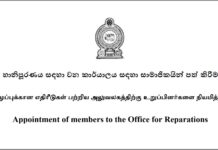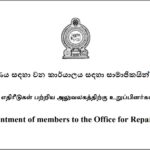By : Dr. Roshan Rajadurai
Sri Lanka is a humid tropical country with a two main monsoon seasons endowed with well distributed year-round rainfall. Tea is the only major perennial commercial economic crop grown widely in all three elevations and rainfall zones and in 14 Districts under varying temperature, rainfall, elevation, topography and terrain.
It provides direct employment to over 600,000 people engaged in cultivation and processing and indirect employment to a further 200,000 involved in the supply chain. Thousands of townships and village economies in tea growing areas are sustained by and completely depend on the tea industry. The sector provides complete livelihood support for a resident population of one million in Regional Plantation Companies (RPCs) and 450,000 tea smallholder operators, hence supporting a total population of nearly 1.5 million.
Overall, considering both employment and livelihood generation, the industry sustains more than 10% of our national population and its net foreign exchange earnings are only second to the garment industry. It is a total home-grown export industry from the production of raw materials to the finished goods, except for fertilizer and certain agro chemicals, all inputs are local and hence all the money earned is circulated within the country. In 2020, Sri Lanka earned Rs. 260 billion from tea which was circulated within the country.
Tea is an evergreen woody perennial plantation crop grown in large extents and contiguous swathes of land for commercial crop extraction. Cultivations are generally monoculture, with other plant species grown to provide shade. The use of green manure, cover crops, hedge rows and intercrops by tea plantations, together with homogenous cultivation and below the ground plant physiology and ecosystem, provide favourable conditions for various groups of pests and diseases to establish, spread, disseminate and survive. These pests and diseases which affect the leaf, stem, branch and roots cause significant crop loss and plant damage during various periods of the year and different crop growth stages.
Use of Integrated Agriculture Management
Tea requires timely use of synthesized chemicals such as fertilizer, herbicides, fungicides, pesticides, growth regulators and concentrated fertilizers. However, plantation agriculture has always practiced Integrated Agriculture Management (IAM), since no agriculture can rely 100% on either synthesized agro chemicals or organic inputs. Plantations have carefully followed ecologically protective, environmentally sustainable, economically feasible and ethically acceptable adaptation and mitigation techniques and practices under varying spatial, temporal, climatic and geographical conditions.
IAM in plantations is required to be financially viable, agriculturally productive, ergonomically practical and culturally compatible within a holistic sustainable plantation management framework. Plantations have strictly complied with the minimum use of agrochemicals because of global certifications, compliance and conformance standards set out by global regulatory agencies and importing countries while conforming to the very exacting, stringent and varying Maximum Residue Level (MRL) requirements required by all buyers.
As a result, Sri Lanka’s tea industry is the most certified tea industry in the world. Nearly 300 RPC factories have more than 625 global certifications such as Ethical Tea Partnership (ETP), Rainforest Alliance (RA), UTZ, Good Agricultural Practice (GAP), Sustainable Agriculture Network (SAN), Hazard Analysis Critical Control Point (HACCP), Fairtrade (FT), Mother and Child Friendly Estates, Forest Stewardship Certificate (FSC), ISO 22000, ISO 9000 and many other environmental, sustainable and green certifications. Ceylon Tea was declared the ‘Cleanest Tea’ in the world by the Food and Agriculture Organization (FAO) and was first to be certified ‘Ozone Friendly Tea’ in the world, with over 170 countries consuming our tea. Sri Lankan plantation companies have won global awards for sustainable environmental practices regularly in the international fora.
Tea plantations have followed integrated plant nutrition management (organic, inorganic, green manure and bulk manure fertilizer applications), integrated weed management (preventive, cultural, agronomic, manual, chemical, biological, ecological and mechanical methods), integrated plant protection management (fungicides, insecticides, acaricides, nematicides, fumigants and weedicides), integrated pest management (cultural, biological, chemical and microbial control methods), integrated disease management (agronomic, cultural, biological and chemical strategies), sustainable soil and fertility management (physical, vegetative, cultivation and recapture techniques) and total ecosystem management (soil, water, biotic, abiotic ecosystem and the environment), in managing agriculture and crop production.
Requirements of commercial plantations
Commercial plantation agriculture requires balanced, essential plant nutrients in a timely manner and in adequate quantities at affordable prices and weed control in a timely and environmentally-friendly economic manner. It also requires control of seasonal and serious pests and diseases before reaching contagion level, control of climate and weather-related diseases effecting tea bush and crop and fast control of leaf and root diseases before they spread.
In addition, rectification of soil nutrient deficiencies and soil acidity, care and maintenance, formative growth of new clearings and young plants, assisting the rehabilitation and restoration of soils and soil fertility status are also necessary. Ensuring the required quality and physical condition of raw materials and maintenance of essential chemical quality characteristics and physical features for tea quality are all part and a result of IAM in tea plantations.
Agro chemicals and organic inputs are required for vital plant physiological functions such as respiration, photosynthesis, water and nutrient uptake and distribution throughout the plant, growth and cell division, hormonal function and to tolerate biotic stress from pests and diseases and abiotic stress from climate and weather-related issues.
Tea plants require three macro/major nutrient elements (nitrogen, phosphorus, potassium), three secondary nutrients (calcium, magnesium, sulphur) and 10 micro/trace elements (iron, zinc, copper, boron, manganese, silicone, molybdenum, sodium, cobalt, chloride) together with carbon, hydrogen and oxygen.
All these essential nutrients are required in a timely manner at correct dosages for vital plant physiological functions and crop growth. In the arable soil, 50% is solid and 50% is aerosol and of the 50% solid material only 5% is organic and 95% is inorganic compounds such as silicates, oxides, aluminium, calcium, iron and other minerals.
The weight of soil in one acre to a depth of six inches is one million kilos. It works out to 15 million kg of soil to a depth of three feet root zone, for one hectare. The addition of a maximum of 750 – 1,000 kg of inorganic fertilizer per year makes it impossible to bring about a dramatic change in soil composition. No soil in any part of the world is able to continuously supply the full requirement of nutrients for the production of economically significant crop yield without being supplemented by fertilizers.
Any deficiency of essential plant nutrients will retard growth and development and will eventually result in decreased growth, structural abnormality and death of tea plants as 20-50 harvestable shoots are removed from a tea bush every week, continuously for five years.
Balanced plant nutrition
In Sri Lanka, extensive field trials on use of inorganic synthetic fertilizer has been conducted since the beginning of the 20th century. Synthetic fertilizer was introduced to the tea industry in 1905. Eden started trials with different NPK levels as a balanced fertilizer in 1931.
Fertilizer recommendations for Tea has been issued by the Tea Research Institute (TRI); Tolhurst 1954, Joachim 1963, Fernando 1969, Sivasubramanium and Jeyaram 1976, Wettasingha and Watson 1980, Wickramasinghe 1986, Hettiarachchi 2003 and Zoysa and Loganathan 2003.
In the 1970s, TRI recommended ERP as a source for Phosphorus. In the 1980s, urea-based regional specific fertilizer replaced Sulphate of Ammonia. In 1985, fertilizer based on yield potential was introduced. In 2000, site specific fertilizer recommendations (SSFR) were introduced based on soil testing for P, K, Mg., S, pH and yield potential for different agro ecological regions. In 2010, regional specific fertilizer applications were recommended. Nitrogen is the most critical nutrient for tea and tea requires nitrogen more than any other plantation crop, because of the vegetative nature of harvesting done every six to seven days.
Impact of synthetic fertilizer
The TRI recommended fertilizer mixtures, after almost a century of trials and research. These provides high nutritional value per unit of fertilizer are available in highly soluble and plant absorbable forms while taking in to account correct nutrient ratios and other nutritional antagonistic and synergistic complexities of plant and soil. They provide plant growth specific, seasonal, crop, soil and site-specific formulations.
They are precise, defined and controlled with specific need-based and precisely targeted dosages with soil and leaf testing for specific purposes including deficiencies and at formative growth stages. Synthetic fertilizer is consistent with no variability across batches, predictable in its response and have a reduced presence of undesirables in its formulation.
It can correct specific plant and soil nutrient deficiencies fast and its fertilizer efficiency usage is high. It is easy for crop planning and when all compounds in fertilizer mixtures are known and tested with no chance for unknown compounds, plant pathogens or soil borne root pathogens to be incorporated in the process of manufacture. It has the ability for use in spot applications and for any specific deficiency by foliar applications of micro nutrients, in particular.
Synthetic fertilizer is economic, cost-effective and convenient for collection, transport, storage and application and is available in required quantities at the required time. Generally, a maximum of four workers per hectare (Ha) is used for ground application of synthetic fertilizer and a maximum 60 – 80 Nitrogen per Ha is applied.
There are specific and different types of fertilizer applied with multiple elements, mixtures, nutrient compositions, dosages, frequencies and time of applications for different stages of tea plant growth. This ranges from rehabilitation, tea seed bearers, clonal mother bushes, nursery stage, immature stage, formative growth stage, restorative stage and mature stage, going up to 100 years maturity vintage. Different origins of tea such as seedling tea and vegetatively propagated tea, different clonal cultivars, different yield slabs, elevations, soil types and soil conditions require different fertilizer mixtures.
According to the validated research findings of TRI, crop loss without balanced plant nutrition is around 30% – 40%. Tea Research Foundation of India too has confirmed that this would result in more than 30% yield loss. Fertilizer recommendations and applications are highly complex undertakings and are the combined result of over 90 years of validated, painstaking scientific research and trials on fertilizer by the TRI, which has won global acclaim and recognition for its pioneering work in this area of research.
Balanced plant nutrition and tea quality
Timely and balanced plant nutrition has a direct impact on the tenderness of fresh shoots, vigour and increase of Chlorophyll content and desired chemical compounds in the tea leaf that contributes to essential tea quality parameters on which a tea is assessed. These include black appearance of made tea, colour of infused leaf and tea liquor characters of the infusion such as colour, strength, quality, aroma and flavour.
To achieve these physical and organoleptic quality parameters, it is critical to apply the recommended balanced fertilizer mixtures of the right quality and quantity, at the right frequency, dosage, method and timing. Tea leaf, as the only raw material in tea manufacture gets its physical conditions such as succulence and tenderness to facilitate different stages of tea manufacture and its chemical characteristics that determine its quality through balanced plant nutrition.
Lack of plant vigour makes plants susceptible to attacks by pests and diseases and to climate change effects which have a direct impact on quality. Diseases such as blister, blight and pest attacks from mites and tea tortrix not only result in severe loss of crop through its impact on harvestable shoots but also causes significant reduction of important and natural plant precursors that determine the quality of tea.
Nutrient deficiencies directly affect formation of chlorophyll and other desired chemical compounds and physical attributes of the tea leaf. Quality of tea is primarily determined by its physical appearance, chemical constituents and fibre content of made Tea. Nitrogen is required for protein, amino acids, caffeine and theanine and is critical for enzyme synthesis.
Phosphorus is required for formation of volatile flavour compounds and aroma complex that are essential in terms of quality. Potassium is an activator and a catalyst of important precursors contributing to quality. Magnesium is required for chlorophyll production which is critical for the black appearance of made tea and is required as a catalyst for precursors contributing to quality. Copper is required for enzyme PPO and for brightness of tea. Zinc is an important co-enzyme and di-ammonium phosphate contributes to the liquor colour.
Challenges due to lack of plant nutrition
The absence of balanced plant nutrition with all the required macro elements, secondary nutrients and trace elements would have a significant impact on the overall quality and taste of Ceylon Tea. For over 100 years, the consumers are familiar with and are used to the quality of Ceylon Tea. It is estimated that the quality of tea would reduce by 30% to 40% due to the lack of timely availability of balanced plant nutrition and adverse effects of pests and disease.
This would be an irreversible setback for Ceylon Tea – both in terms of quality and reputation. Once consumers move away from ‘Ceylon Tea’, they are gone forever and ‘Ceylon Tea’ would lose a hard-won market which has been established under tremendous difficulties and competitive challenges over the last 100 years. A case in point is the example of the premium, highest-paying Japanese market which ‘Ceylon Tea’ lost after the Glyphosate ban fiasco.
Without the availability of appropriate balanced plant nutrition, recommended herbicides for weed management, approved agro chemicals for pest and disease management and for the mitigation of climate effects the crop and quality levels of Ceylon Tea would irrevocably decline to uneconomic levels. The crop loss will increase the cost of production to unimaginable levels and locally, no one would be able to manage tea plantations in a sustainable manner as revenue received at auctions for such tea would be a fraction of the cost of production incurred.
The quality drop would result in Ceylon Tea being not sought after and all these would singularly and in combination spell doom for the 150-year-old Ceylon Tea industry which is a well-known global brand. Along with the diminution or collapse of the industry, employees engaged in the industry would suffer significant loss of earnings. This could lead to unemployment, poverty, reduced quality of life and abandonment of tea fields, closure of tea factories and other related and associated issues.
The socioeconomic, financial and livelihood impact on the resident population within RPC estates, with no recourse to alternate employment or income would be truly disastrous. Ceylon Tea has experienced some effects of this nature after the ban only of herbicides for weed management and the deleterious and adverse after effects of the ban are clearly evident even now.
Many warnings of what would happen were repeatedly brought to the attention of the authorities by the author himself on many occasions. Without the availability of plant nutrients and agro chemicals now envisaged. The impact is irreversible and beyond imagination.
Total earnings from Tea amounts to Rs. 260 billion or USD1.3 billion.
Total cost of fertilizer for tea amounts to Rs. 6 billion or USD 30 million.
The cost of fertilizer as a percentage of earnings from tea is only 2%.
Once started, the slide to oblivion is obvious and irreversible.
The acclaimed American economist J. K. Galbraith stated ‘farmers rightly sense in the counsel of any man who does not have to live by the results of the consequences of such counsel’. Planters and those engaged in plantation agriculture are now compelled to work in the industry, based on the decisions and advice of those who don’t have to deal with the results of such advice.
Author, Dr. Roshan Rajadurai:
Dr. Roshan Rajadurai is the Managing Director of the Plantation Sector of Hayleys PLC (which comprise Kelani Valley Plantations, Talawakelle Tea Estates and Horana Plantations). A former Chairman of the Planters’ Association of Ceylon, Dr. Rajadurai has 36 years of experience in the plantation sector.












